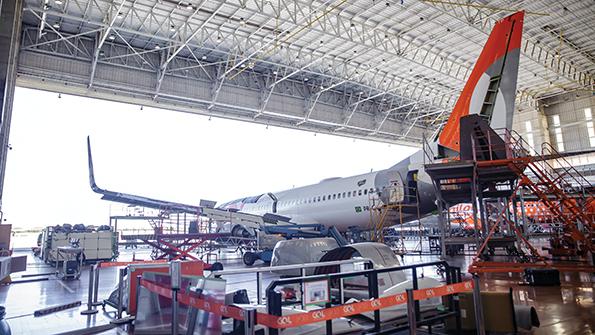
It’s summertime, and the flying is easy in Brazil. The return to growth has been good news for Brazil’s airlines and their MROs as well as those supporting non-airline aviation.
Though the COVID-19 omicron variant has had an impact on the giant Latin American nation, fatalities remained minimal through the first two weeks of January. Real GDP, which contracted sharply in 2020, is growing again. Meanwhile, Brazil’s domestic flights, which fell to just 8% of normal schedules in May 2020, had risen to about 90% of pre-COVID-19 levels as of early January 2022. International flights rose to 55% of normal schedules in the same period.
Low-cost carrier GOL Transportes Aereos, Brazil’s largest domestic airline but only a minor player in international service, has benefited from the strong domestic recovery. Capacity was up 21% in the fourth quarter of 2021, compared with the same period of 2020, while passenger traffic rose 15% and unit passenger revenue was up a very healthy 35%. Maintenance on the airline’s 123 Boeing narrowbodies is returning to robust levels.
GOL Aerotech, a new venture that offers third-party maintenance on Boeing 737s and 767s, is also looking at much better prospects as traffic in Brazil recovers.
Aerotech was launched in December 2019 on the eve of the COVID-19 crisis—just about the worst possible time for a new MRO venture. However, Aerotech supported some customers even in the trough years of 2020 and 2021, and it is now in active negotiations with others.
“We do see an impressive increase in the demand for heavy checks and paint jobs,” says Carlos Alberto Costa, director of GOL Aerotech. Costa says demand for heavy checks on both Airbus A320s and 737s has increased dramatically in the past few months.
GOL Aerotech has put in place several measures aiming to avoid mass layoffs during the COVID-19 crisis. These include union agreements, work-from-home policies and temporary layoffs.
“Those measures were efficient, and we were able to keep our highly trained and experienced team, which places Aerotech in a singular position for the demand recovery,” Costa says.
GOL Aerotech is now expecting demand to increase to pre-pandemic levels in the next 12 months.
With recovery well underway, the biggest challenge now is securing materials. Part production and parts in the supply chain have reached extremely low levels globally, Costa notes. Rebuilding stock to ideal levels will thus require more rapid increases in parts supply than increases in demand over the next couple of years. Fortunately, the airline does not “see any struggle with manpower availability in the short term,” he says.
GOL Aerotech plans to expand its presence in the MRO market by adding new facilities, but specifics have not yet been announced. The company is actively increasing its certifications to expand its reach in Latin America; with the Boeing 737 MAX added to its portfolio already, it is now carefully planning the addition of the Airbus A320 series. Costa says GOL Aerotech is also studying new component-repair capabilities and strategic partnerships to repair engines, landing gear, APUs and other components.
Unlike Aerotech, Lider Aviacao has been around for more than six decades. It charters, maintains and sells business aircraft, provides airport services, and flies rotorcraft for oil and gas producers. Lider’s maintenance unit serves both its own fleet of 50 aircraft and fleets of other customers. The maintenance unit has experienced significant demand, even during the pandemic.

Lider MRO started 2020 with an ample backlog, but COVID-19 and health rules caused a significant drop in traffic by the spring. “With aircraft on the ground, owners took the opportunity to carry out maintenance service,” explains Rodrigo Barbosa, maintenance director for Lider MRO. “This backlog remained high until mid-2021,” he says.
Then, in 2021, new aircraft types entered private aviation in Brazil, including nine Gulfstream jets. New work for Lider came from pre-purchase inspections of both fixed- and rotary-wing aircraft.
Lider has partnered with Gulfstream as an authorized service center and parts sales center since 2019. This partnership has helped to increase Lider’s MRO backlog and has enhanced its expertise over the last two years. In April 2021, the U.S. OEM added another partnership, for parts consignment, and Lider now operates a warehouse with more than 2,400 Gulfstream parts.
The MRO also carried out large-scale inspections in 2021, such as the 48-month check on a Gulfstream G4. Another inspection of an aircraft of the same size is set for this month.

In addition to its civilian work, Lider modernized instrument panels on three Brazilian Air Force Hawker 800 XPs.
“During the pandemic, the company also has won bids for new maintenance contracts for executive aircraft in six states—Acre, Goias, Paraiba, Pernambuco, Santa Catarina and Rio Grande do Sul—and in the Federal District,” Barbosa points out. Executive aviation has become critical in tying together the far-flung governments in this huge country, especially when commercial flying was limited by the pandemic.
Lider has been expanding its on-site maintenance services as well, reducing MRO costs by moving tools and professionals to aircraft bases.
Overall, in 2020 and 2021, Lider supported 384 fixed-wing aircraft under 18,000 service orders in its four maintenance centers in Belo Horizonte, Brasilia, Rio de Janeiro and Sao Paulo.
Rotorcraft MRO has also been a hot market. Sao Paulo and its surrounding region have one of the largest helicopter fleets in the world, with 411 registered rotorcraft. Lider performed maintenance on 81 of those rotorcraft in 2020 and another 87 in 2021, giving it about one-fifth of the potential market.
Despite the encouraging growth, Barbosa acknowledges that Lider’s supply chain has been affected by the pandemic. “Recently, for example, there has been a shortage of tires,” he says. Lider mitigated this problem by proactively making a large purchase of tires in September 2021.
Lider’s maintenance unit now employs 160 people, with an average length of service of 9-10 years. It will soon launch a mobile MRO application and has applied for certification in Argentina.





